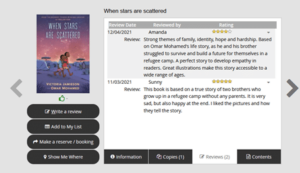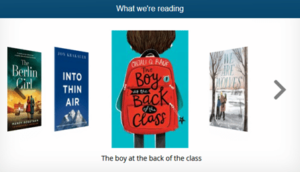Engaging Students in Your School Library
Feb 20, 2024
Involving students in the operations of your school library benefits their reading engagement, fosters a school-wide reading culture, provides leadership opportunities, and promotes the library’s role within the school. When students feel heard and see their suggestions implemented, they feel valued, which increases their connection to the library. Here are ways to get students actively involved.
Collection Development Suggestions
Increasing reading engagement can be achieved by allowing students to choose the books they read. Providing the books that your students ask for will also ensure that your school library collection is relevant and reflects the specific reading interests of your students.
Here are some strategies:
- Wish List: Invite students to add books to the library’s wish list.
- Suggestion Notebook: Place a colorful notebook in the library for book suggestions.
- Suggestion Wall: Designate a wall for students to add Post-it notes with book ideas.
- Google Form: Create a form and share the link on the Accessit Web App and other online spaces.

- Prompt Purchases: Buy suggested books quickly to show students their input matters.
- Reserve Queue: Prioritize students who suggested the books in the reserve queue, easily managed in Accessit Library.
- Student Interests: Talk to students about their favorite genres, authors, and topics.
- Profile Updates: Encourage students to add interests to their borrower profile in Accessit Library Web App to receive alerts for new resources.
- Trending Formats: Include popular formats like manga, audiobooks, and graphic novels.
- Series Monitoring: Encourage students to inform you about upcoming books in popular series.
- Book Buying: Take students on book-buying trips or involve them in online orders for new books.
Conversations and Recommendations
Talking about books enhances the social aspect of reading, motivating students to try new books recommended by their peers. Here are some ideas:
- Shelf Talkers: Give students shelf talkers or bookmarks to leave mini-reviews on books.
- Review Videos: Encourage students to create and share book review videos and trailers on YouTube, then add them to Accessit Library Web App Topic Boards.
- Recommendation Cards: Print “Read this – we think you’d love it” cards for students to recommend books.
- Online Reviews: Motivate students to write book reviews in Accessit Library Web App, potentially as a class activity.

- Recently Reviewed Carousel: Set up a carousel for recently reviewed books in Accessit Library Web App.

- Online Book Groups: Create a Goodreads group for students and embed content in Accessit Library Web App.
- Multiple Copies: Buy multiple copies of popular books for group reading.
- Favorite Books Displays: Set up displays for students to share their favorite books with Post-it notes.

- Social Media: Use platforms like Padlet and Instagram for students to share book recommendations.
- Book Trailers: Play book trailers on a screen in the library during breaks to spark discussions.
Creating a Welcoming Library Environment
Give students a sense of ownership by involving them in the library’s aesthetics and operations:
- Student Art: Display student artwork and other projects in the library.
- Library Displays: Have students help create displays and get their feedback on the layout.
- Comfortable Spaces: Create calm, comfortable reading areas with student input on design.
Identifying Collection Gaps
Always consider collection gaps before budget submissions to show how filling these gaps benefits students. Use your school library management system to identify these gaps.
- Popular Author Reports: Ensure all works by popular authors are included and consider additional copies.
- Comparative Reports: Identify engagement differences across age groups or reading trends.
- Usage Reports: Determine what is being used in the existing collection and what needs replacement.
Collaboration with Departmental Heads
Engage with departmental heads to understand the school curriculum and ensure the library collection supports it. This helps in planning resource subscriptions and acquisitions for the year ahead.


Leadership Opportunities
Encourage students to take on roles such as library helpers, workers, advisors, technicians, and ambassadors. Publicly acknowledge their efforts with badges, certificates, and increased responsibilities. You can download certificate and badge templates from the Accessit Library e-Learning Centre (ALeC).
Involving students raises the profile of the library, increases engagement, and highlights the library’s importance in supporting learning and achievement.
References
- Holzweiss, Kristina A. and Stony Evans. Hacking School Libraries: 10 Ways to Incorporate Library Media Centers into Your Learning Community. Highland Heights, Ohio: Times 10 Publications, 2018.
- Merga, Margaret. “‘We Talk Books’: Teacher Librarians Promoting Book Discussion to Foster Reading Engagement.” English in Australia 55 (2020): 22. Accessed April 6, 2021. https://link.gale.com/apps/doc/A643530197/PROF?u=per_k12&sid=PROF&xid=dd9dacc6.
- Merga, Margaret and Veronica Gardiner. “The Role of Whole-school Literacy Policies Supporting Reading Engagement in Australian Schools.” English in Australia 53 (2018): 37. Accessed April 6, 2021. https://link.gale.com/apps/doc/A578158050/PROF?u=per_k12&sid=PROF&xid=1623a4fa.
- Ripp, Pernille. Passionate Readers: The Art of Reaching and Engaging Every Child. New York: Routledge, 2018.
Related Resources
AI in Action: How a Library Leader Is Empowering Students with Artificial Intelligence
How do you introduce students to artificial intelligence in a way that’s meaningful, responsible, and engaging? Library leader Shannon McClintock Miller is doing just that – and reshaping what library learning looks like. Join us for a live conversation with Shannon as she shares how she’s using AI tools to foster creativity, support research, and […]
Reintroducing the Follett Facilities Suite
Facilities management is now fully aligned with the Follett Software brand. Join us for a comprehensive overview of the Follett Facilities Suite and see how these solutions support district operations while connecting seamlessly with IT, curriculum, and library management. What You’ll Learn: • What has changed with product names and branding • The full set […]
Reporting with Confidence: How Aspen Student Information System Simplifies State Reporting
State reporting season doesn’t have to mean late nights and messy spreadsheets. In this session, Follett Aspen® Student Information System experts demystify the state reporting process and show how to make your data work harder – beyond compliance. Learn how to automate tasks, stay ahead of evolving requirements, and build custom reports that uncover equity […]

